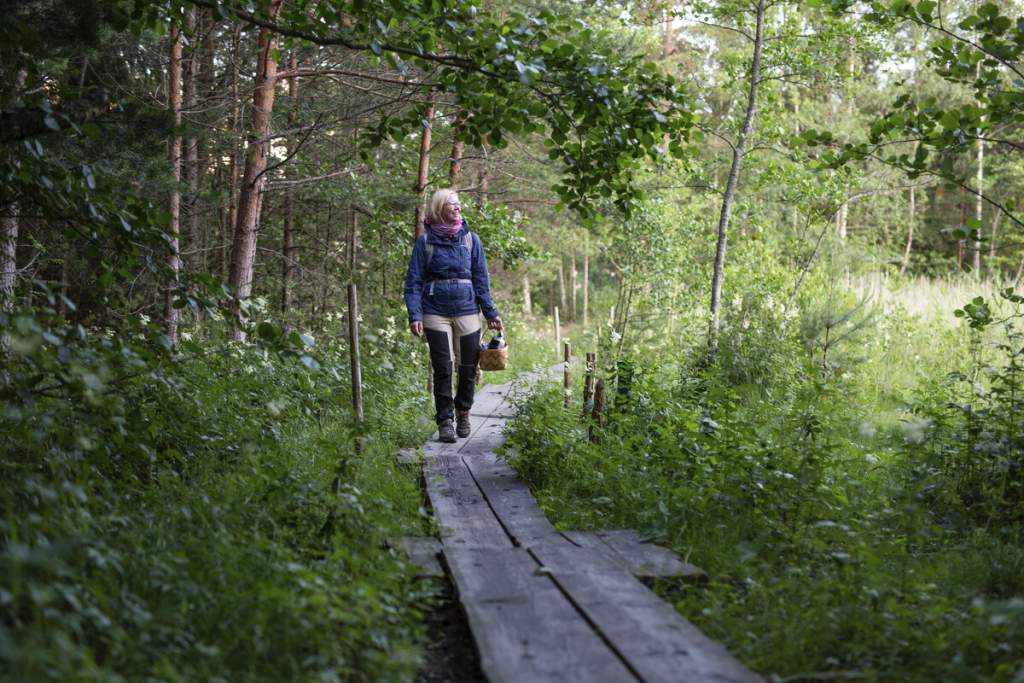
Uutela's figure-eight-shaped nature trail runs through nature reserves. The nature trail consists of two looping trails of different lengths. The checkpoints are marked in the terrain by numbered posts with a pinecone symbol.
Contact information
Forest and pasture landscapes tour
2.5 km, easy access.
Blueberry forests and rocky pinewoods spread out around you. The most common tree species in the blueberry forest is spruce, which is more demanding than pine in its habitat. Can you find typical plant species for a moist heath forest: the delicate twinflower, snaking along the ground and the arctic starflower? The twinflower blooms in midsummer, while the arctic starflower blooms at the beginning of summer.
In this location, the environment has remained in a fairly natural state. When the forests of Vuosaari Manor were logged before the ownership of the farm was transferred to the city, the rocky terrain made logging unprofitable here. Elsewhere, the forests were cut down and are now much younger than these rocky pinewoods.
Uutela is the largest continuous forest area in eastern Helsinki, where you can observe bird species that prefer natural forests.
Were you lucky enough to see or hear the loud Black Woodpecker, the Wood Pigeon that hoots like an owl, the faint chirps of a Treecreeper, or the distinct ‘ti-ti-chay-chay’ call of the Willow Tit?
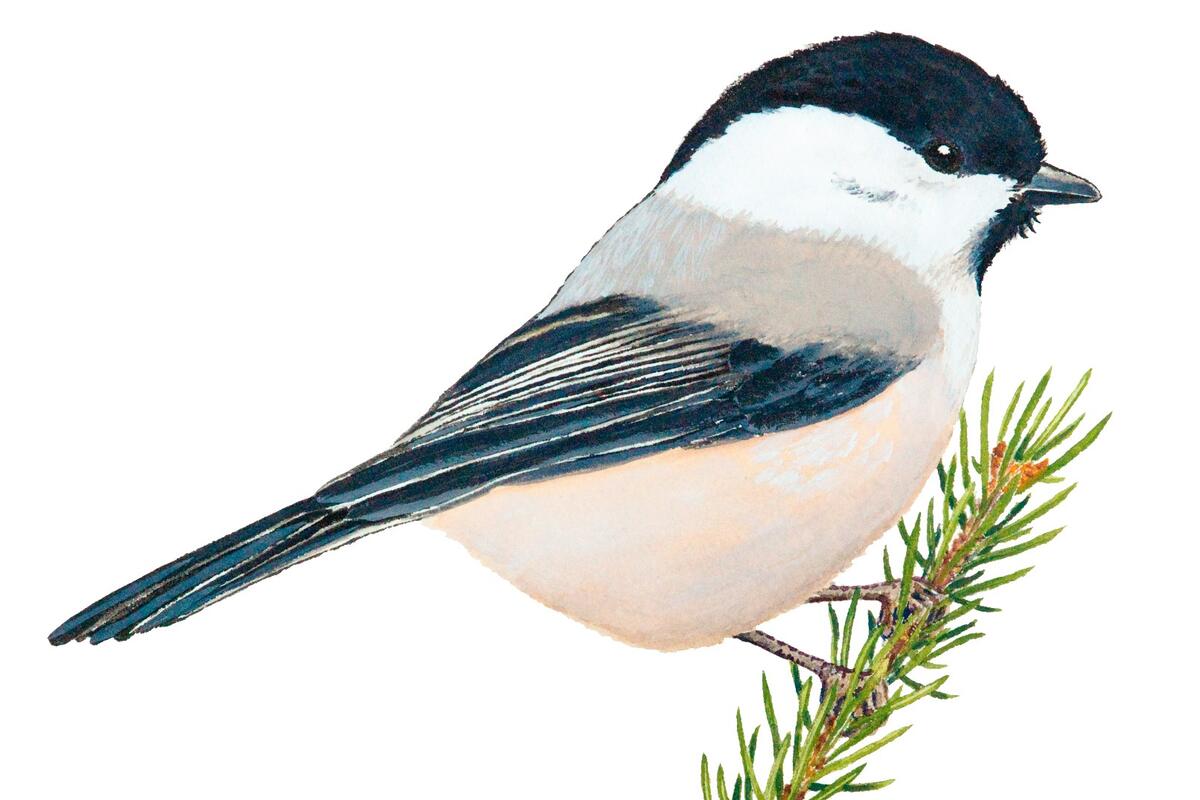
More than 10,000 years ago, this spot was covered by an ice sheet almost one kilometre thick. The hard bedrock was compressed and smoothed by the force of the ice. The result was a flat rock outcrop with an impressive cliff on its edge, which was not ground down by the ice. The rock type of the cliff is partly made up of dark gabbro. Gabbro is an alkaline rock that is rare in Finland, allowing fastidious ferns like the maidenhair spleenwort to grow on the cliff. Even in winter, green polypodies grow in crevices on the cliff face.
Can you see them?
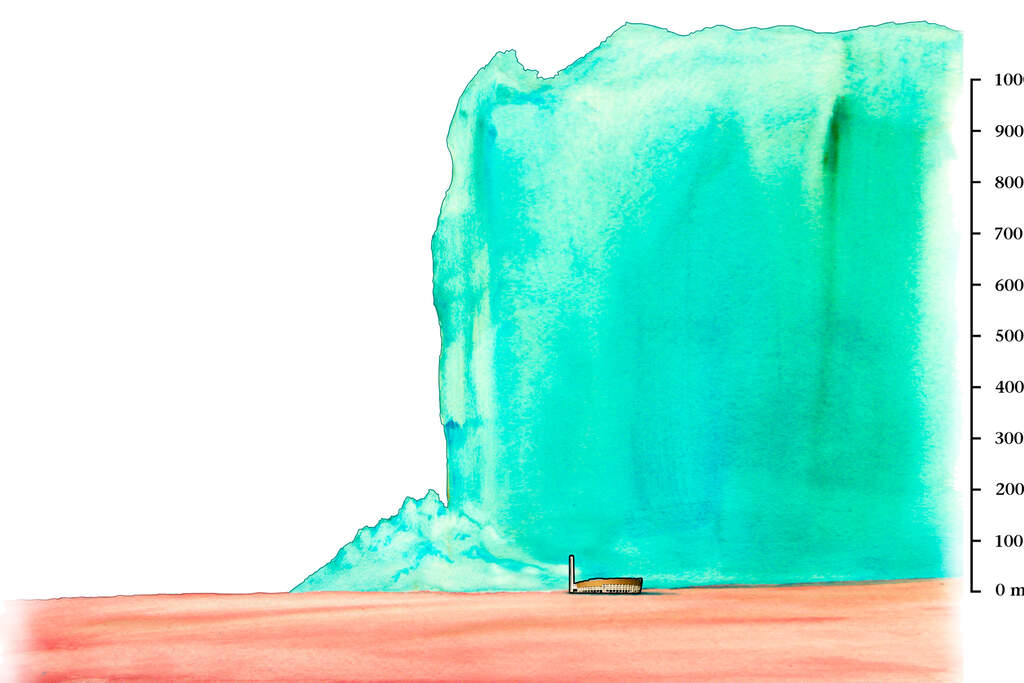
Coastal plants and small animals are very adaptable. They can withstand moisture, being dried by the scorching sun, and the effects of sea salt. Shoreline plants should be tough and have strong roots so that waves, wind and ice don’t carry them away.
Sea level changes and waves continue to shape the shores of Nuottalahti into new forms. During low tide, you can look for seashells in the sand, and at high tide, you can investigate the shapes of stones and rocks. What treasures has the sea washed up on the beach?
Can you see ducks diving or beautiful Mute Swans in the water close to shore? They find food by eating plants on the seabed or fishing for small fish. If you’re very lucky, you might catch a glimpse of a grey seal!
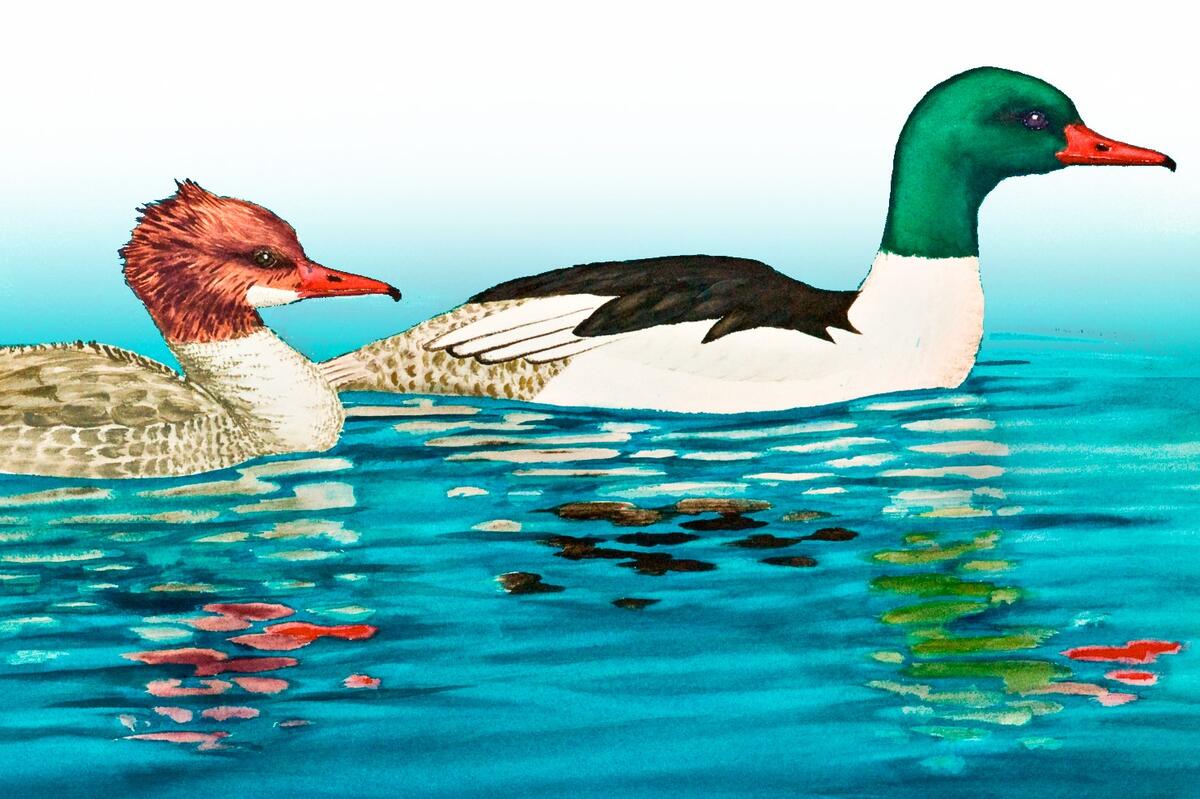
Decaying wood is vital for many organisms. Woodpeckers and some Paridae like to excavate holes into soft wood. The Common Goldeneye, the Great Tit, and some owls use pre-made cavities for nesting, storing food, and shelter from cold temperatures. Uutela has many old trees, standing dead pines, birch trees broken into segments, and fallen spruce trees decaying on the ground.
Fungi decay the wood from the inside out. You can examine tree trunks for which kind of bracket fungus or other fungus lives within. The conks of perennial bracket fungi are easiest to find, while soft annual brackets can only be found in autumn. Some bracket fungi choose their company carefully and only settle on top of another specific bracket fungus species for ‘dessert’. Common bracket fungi, such as the red-belted bracket fungus or tinder fungus, will attack any tree, while rarer varieties only infect certain species, such as spruce or aspen.
How many different kinds of bracket fungi do you see? How many living species can you find on one dead trunk?
The trail to the point leads to a rest stop if you want to take a break and enjoy the sea view!
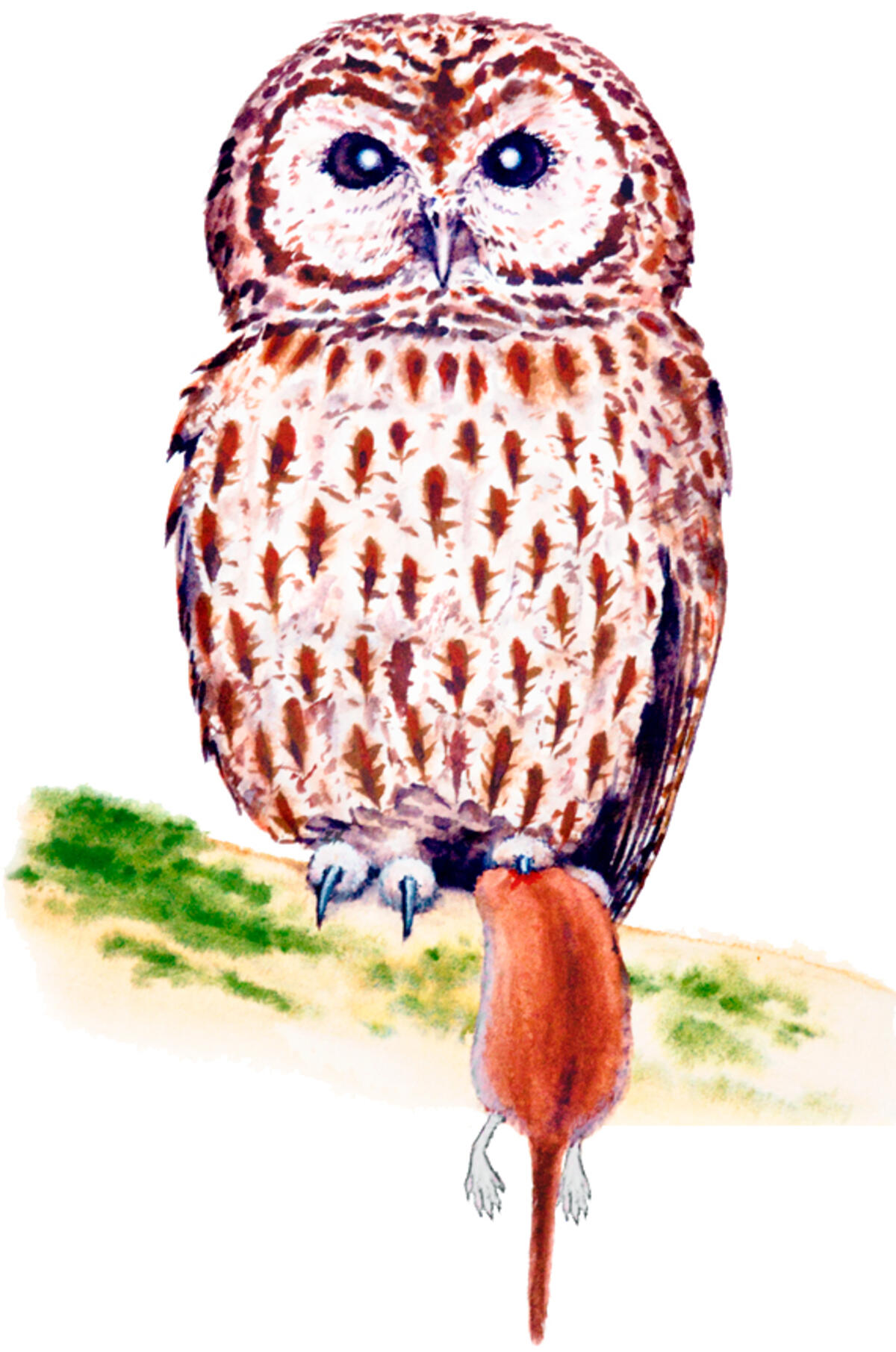
On the right side of the trail, you’ll see a valley that was cultivated for a long time and was originally a shallow seabed. As the land uplifted, nutrients from the sea remained in place, fertilising the clay soil. As farming came to an end, the area was eventually transferred to Helsinki’s Adult Education Institute’s student union and was converted into an allotment garden. The vegetables grown there supplemented the diets of many Helsinki residents in the 1950s, when fresh vegetables were not always available in shops. The 100-square-metre plots (10 x 10) are now used to grow vegetables, berry bushes and ornamental plants.
On the left side of the trail, there are burrows in the ground. A badger has dug burrows here with the long claws on its front paws. A raccoon dog has also lived in these burrows. If a den is extensive, a raccoon dog might live in the upper levels while a badger occupies the lower levels. The allotments and ditches provide food for both animals. Badgers love to eat roots, earthworms and berries, while raccoon dogs will eat almost anything, ranging from frogs to food scraps from rubbish bins.
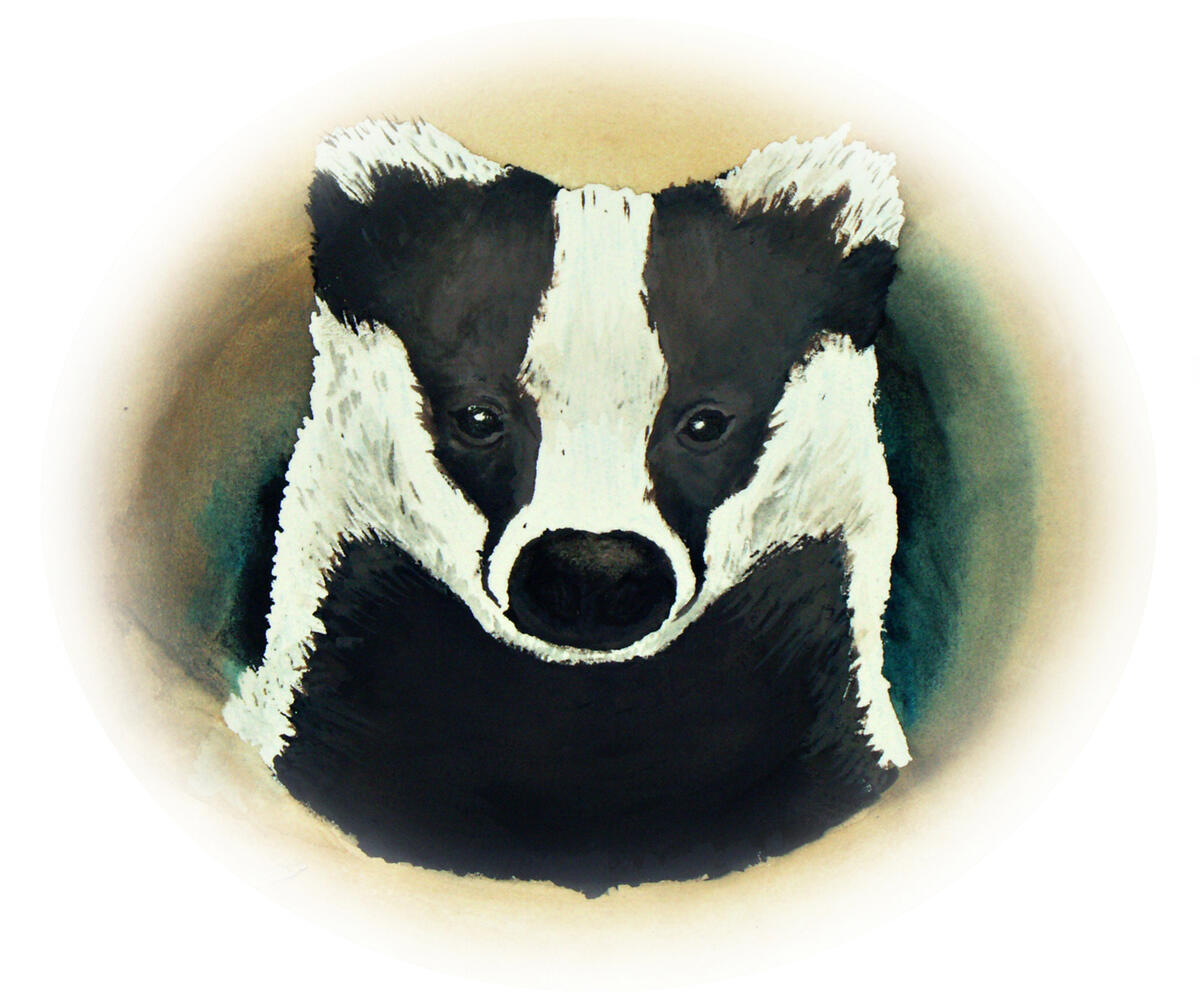
This area also has uninvited guests who are hard to get rid of. Non-native species, such as giant hogweed or rabbits, might be pretty, but they can cause a lot of damage to the indigenous wildlife. Other species that have become established in Finland include the raccoon dog, which spread into Finland from Russia; the Mute Swan brought from China; the mink which escaped from fur farms; and the Canadian goldenrod which spread from garden cultivation. In nature, invasive species are harmful because, in the absence of natural predators, they take over the habitat of indigenous species.
The fragrant Himalayan balsam grows along the trail. It is an invasive species from the Himalayas that has become common in Helsinki. Giant balsam is a garden escapee, i.e. it has escaped into the wild from gardens or allotments. It thrives in moist and lush habitats such as broad-leaved woods, ditch banks and porous soils in mires.
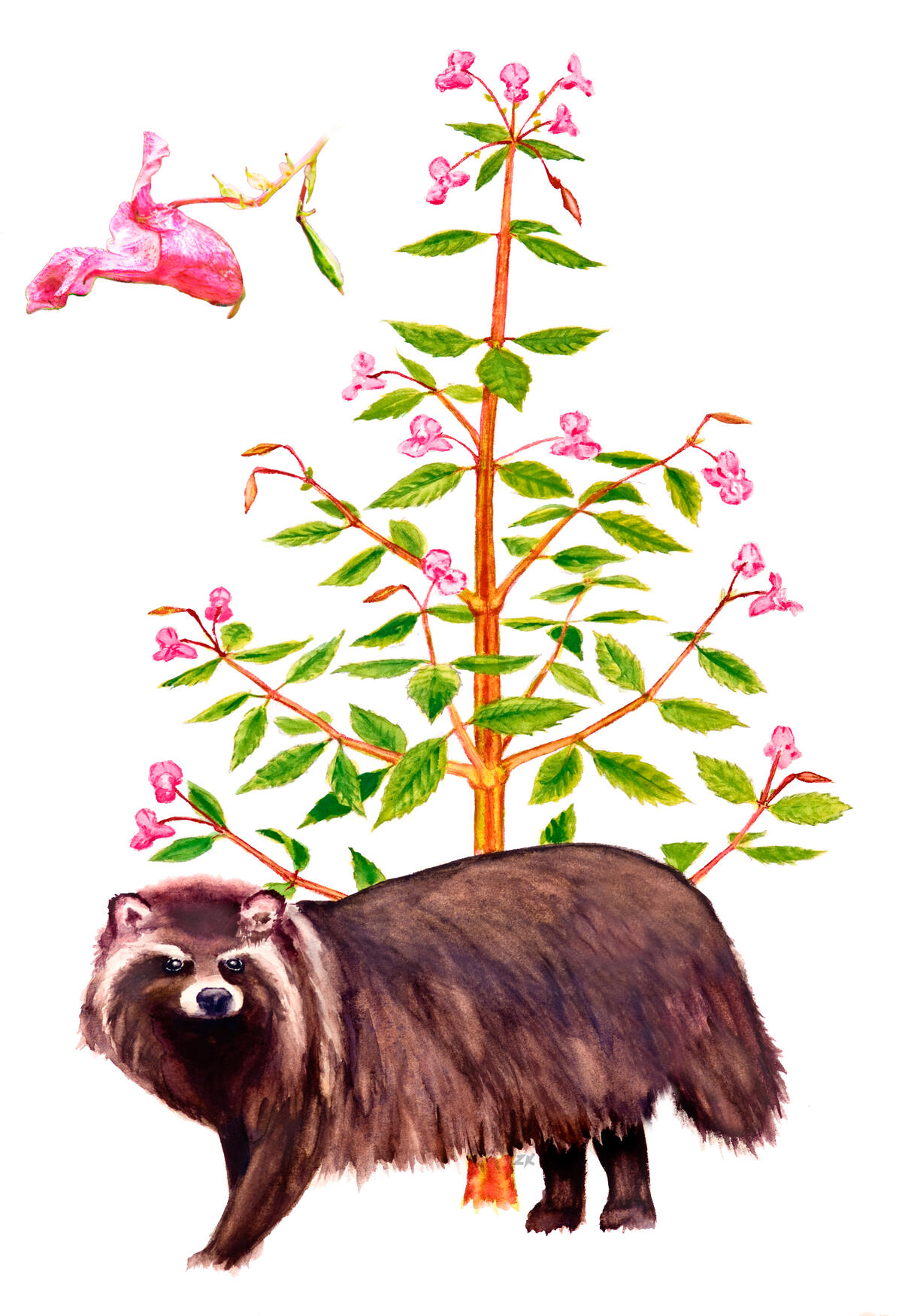
‘I’ve been growing here for nearly 200 years, since the birth of the Tsar and Grand Duke of Finland, Alexander II. I’m proud of my advanced age because my bark is thick and beautiful compared to young pines. I’ve seen a great many things over the years. The valley in front of me has always been farmed, but in my youth, it grew rye and hay for draught oxen in its wettest parts. I thought my end had come during the Second World War when the Russians bombed the almost uninhabited Vuosaari in 1944. The centre of Helsinki escaped significant damage after a major deception operation that blacked out Helsinki and misdirected bombers with fires lit at Vuosaari. Luckily the fire didn’t harm me then as my bark is just now starting to be capable of withstanding the heat of a large fire’.
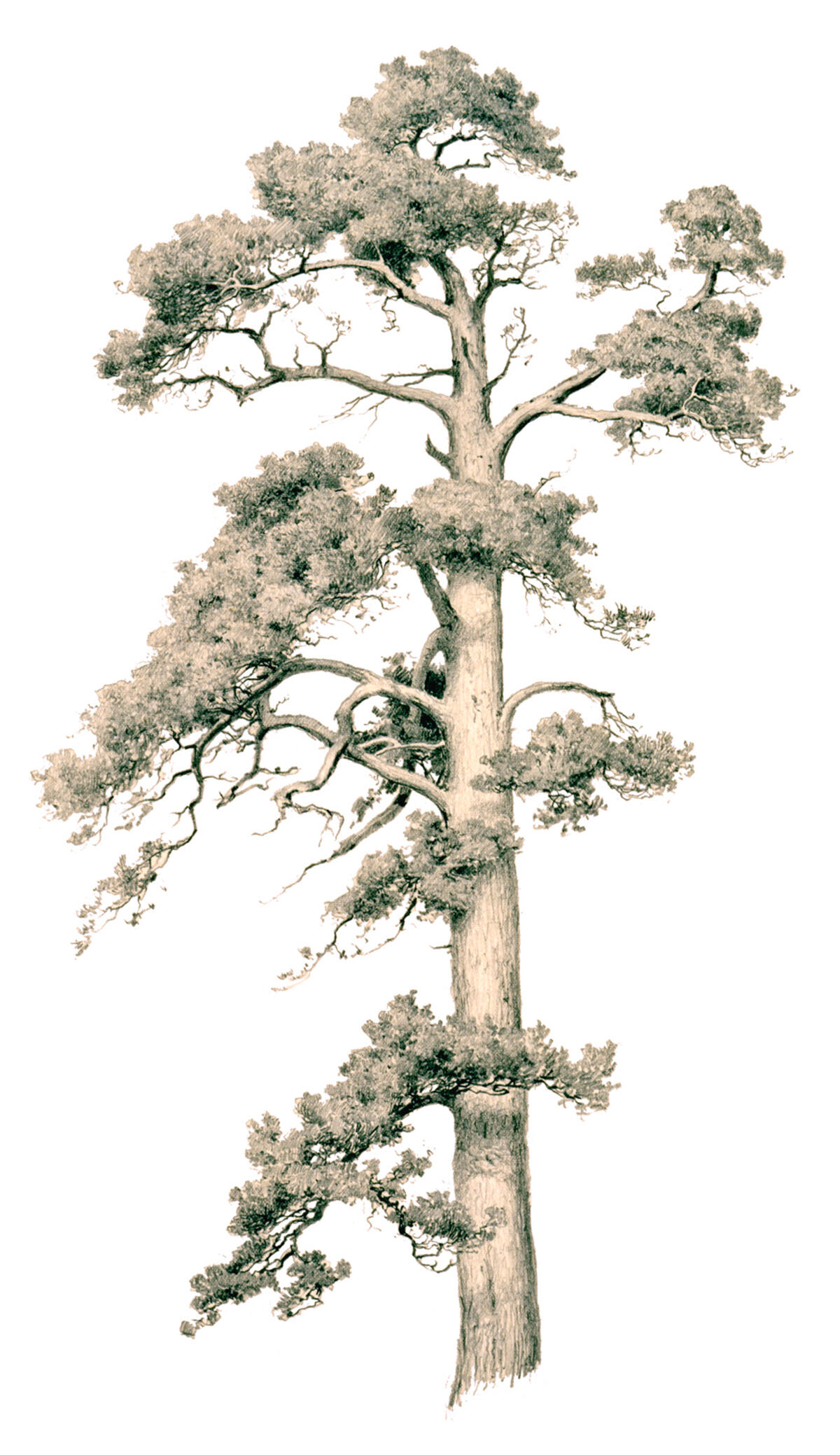
The view in front of you is a rural landscape, hundreds of years in the making. Before the arrival of humans, forests grew here. The inhabitants then cleared the forest for cropland and eventually used the area as an animal pasture. Without grazing, the open landscape becomes shrubby and, finally, a thick forest once again.
Why is there a pile of rocks in the pasture? The heavy rocks were dug out of the ground without an excavator and transported into these piles with horse-drawn carts! Back then, the hay in the field was harvested with a scythe. If the scythe hit a rock, the blade would lose its edge. That’s why it was important to clear out the rocks.
The buildings of Skata Farm, located at the crossroads, date back to the end of the 19th century. In those days, people lived self-sufficiently, from grain and vegetables grown in their fields and fish from nearby waters. The farm probably had a horse as a draught animal, a few dairy cows, pigs and chickens. After the wars, tractors replaced horses on farms, the meadows were turned into grain fields, and cattle were no longer kept.
This is the end of the first tour of the nature trail. You can continue to the second tour through the Särkkäniemi nature reserve or return to the starting point.

Gloe lake and coastal meadows tour
1.5 km, mostly easy to access. PLEASE NOTE! The gloe lake tour runs partly through the Särkkäniemi nature reserve. Read more about restrictions on public access in the nature reserve.
Bats are nocturnal predators of coastal forests, and eat huge numbers of insects on summer nights. In Uutela, you can see the fast-flying northern bat, which is well-adapted to cities; the whiskered bat, which prefers forests; and Daubenton’s bat, which hunts near water.
Under cover of darkness, bats will travel long distances as long as the nightly temperatures are above five degrees Celsius and when rain does not stop them. Bats spend their winters hibernating, e.g. in cellars or other damp and cool hiding places. Some species migrate south. Bats prefer the attics of old buildings. If the spot is suitable, you may even find a colony where many bats roost together.
You can help the bats by building a bat box. In the box, the bats can enjoy their daytime nap protected from owls and cats.

On both sides of the trail, you’ll see Uutela’s unique feature, the flads and gloes! The slow uplift of land after the ice age creates shallow bays, or flads. If the mouth of the bay has a sandbar, it will gradually close off into a gloe lake or pond, which is only connected to the sea at high tide. Later, the gloe will dry out into an open coastal meadow and gradually turn into a forest.
The southern gloe is hidden by vegetation; the common reed grows there, as well as the rarer sea club-rush with its sharply triangular stems. When summer begins, the reed bed is home to the Reed Warbler, a bird with an easily identifiable, crackly call.
In spring, male frogs call females to the pond to spawn. Can you hear them croaking? The female chooses a male to fertilise the eggs that she deposits in the water. The eggs then hatch into tadpoles that will grow in the pond until they become small frogs. You can look, but not touch; the frogs and their spawn are protected.
Dragonflies sparkle like jewels as they fly. Excellent flying skills are necessary, as dragonflies prey on smaller insects. Dragonfly larvae terrorise the underwater environment, where they feed on a wide variety of tiny animals.
You’ll find checkpoint 11 by going back a bit in the direction that you came from.
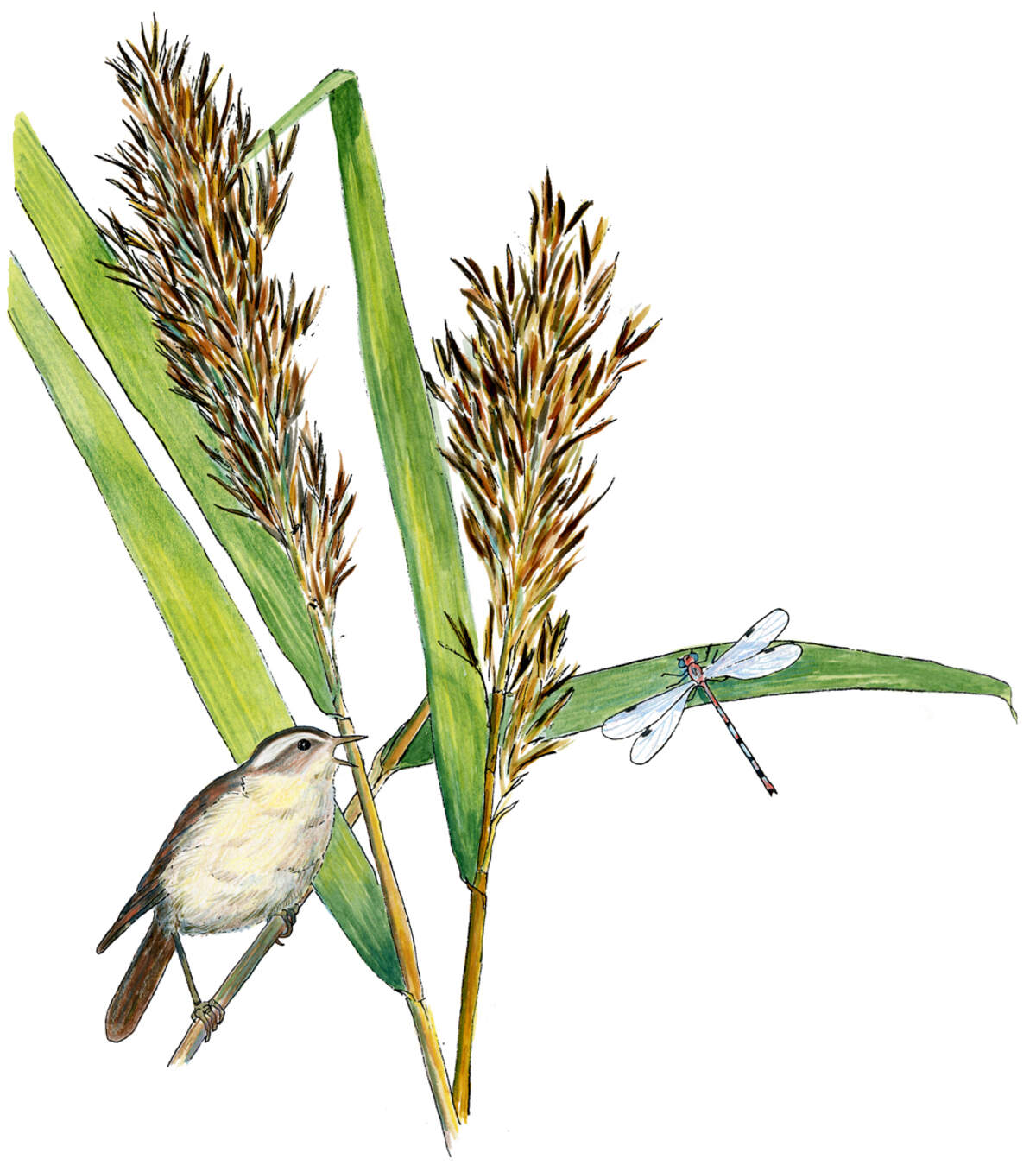
The shores of Uutela are rocky and there is only a narrow strip of coastal meadow. The typical plants of a sea-shore meadow near the water’s edge include saltmarsh rush, seaside arrowgrass and seaside centaury. They are salt plants (halophytes), for which the salinity of their habitat is vital for their survival. The salinity of the Baltic Sea decreases towards the furthest parts of the Gulf of Finland and the Gulf of Bothnia, reducing the viability of salt plants in those areas.
The birdsfoot trefoil is a low plant that grows in the coastal sand and meadows, flowering between June and July. The birdsfoot trefoil is not only a coastal plant, as it is also found in Southern Finland along roadsides, railways, and on ridges. Along the shores of Särkkäniemi, you will also find the garden speedwell, which has blue, spike-like flowers, as well as chives, a familiar member of the onion family.
You’re free to explore the coastal wildlife by continuing on this path, which joins with the outdoor trail a little further along. The beach path can occasionally be wet. A part of the route also passes over duckboards.
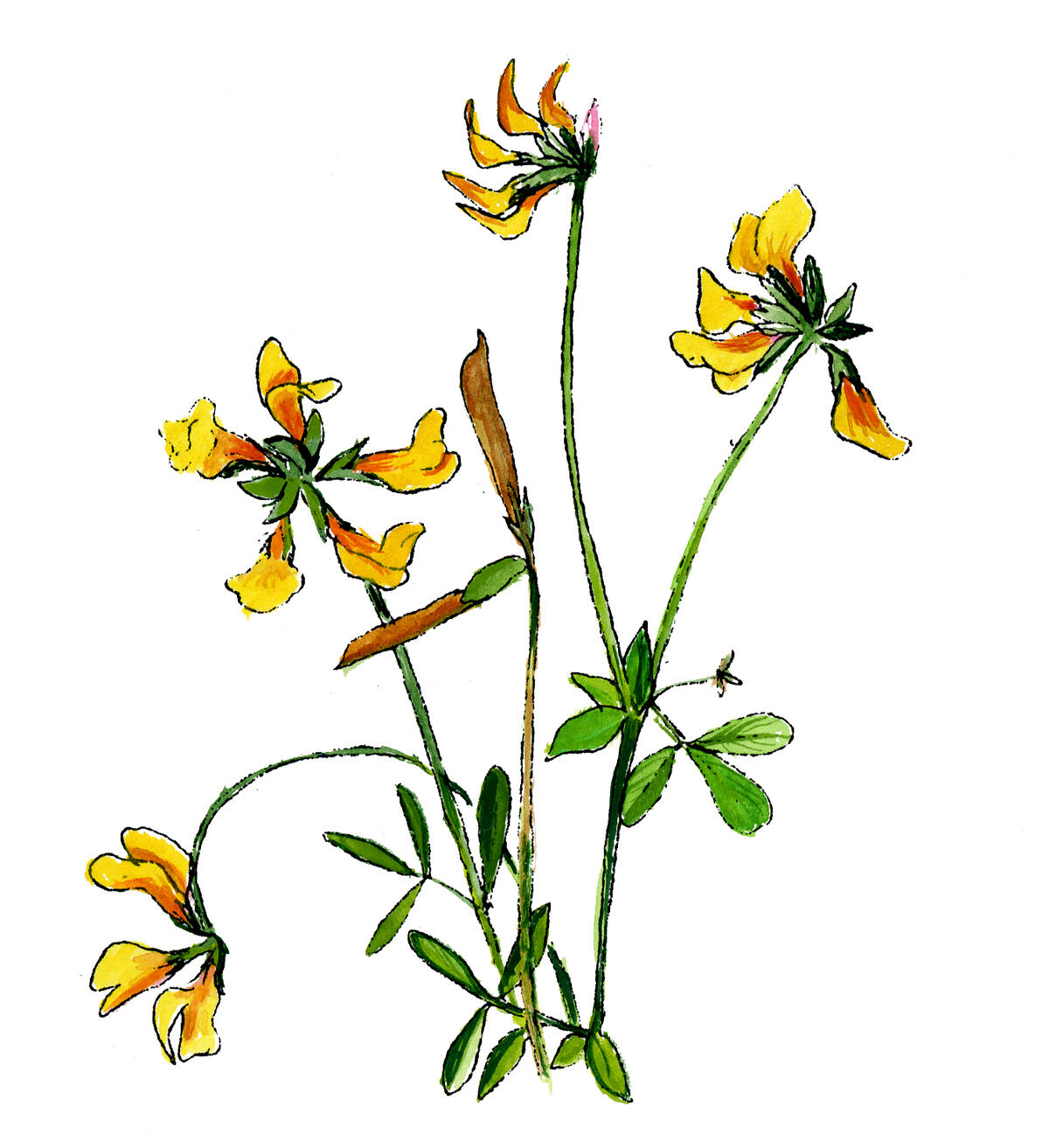
Skatanselkä stretches ahead of you, and the islands of Musta Hevonen and Kuiva Hevonen are barely visible on the horizon. The waves and the southwest wind transform this beach a little each day. On an overcast day, the landscape is greyish, while on a sunny day, the light reflecting from the water is dazzling, and the islands look almost black. Which colours dominate the landscape today?
Autumn storms cause bladderwrack to wash up on shore in huge piles. Bladderwrack is nutrient-rich and provides an excellent substrate for many salt-loving plants. You can also find small arthropods or flies in these seaweed piles; they’re a microcosm of the world!
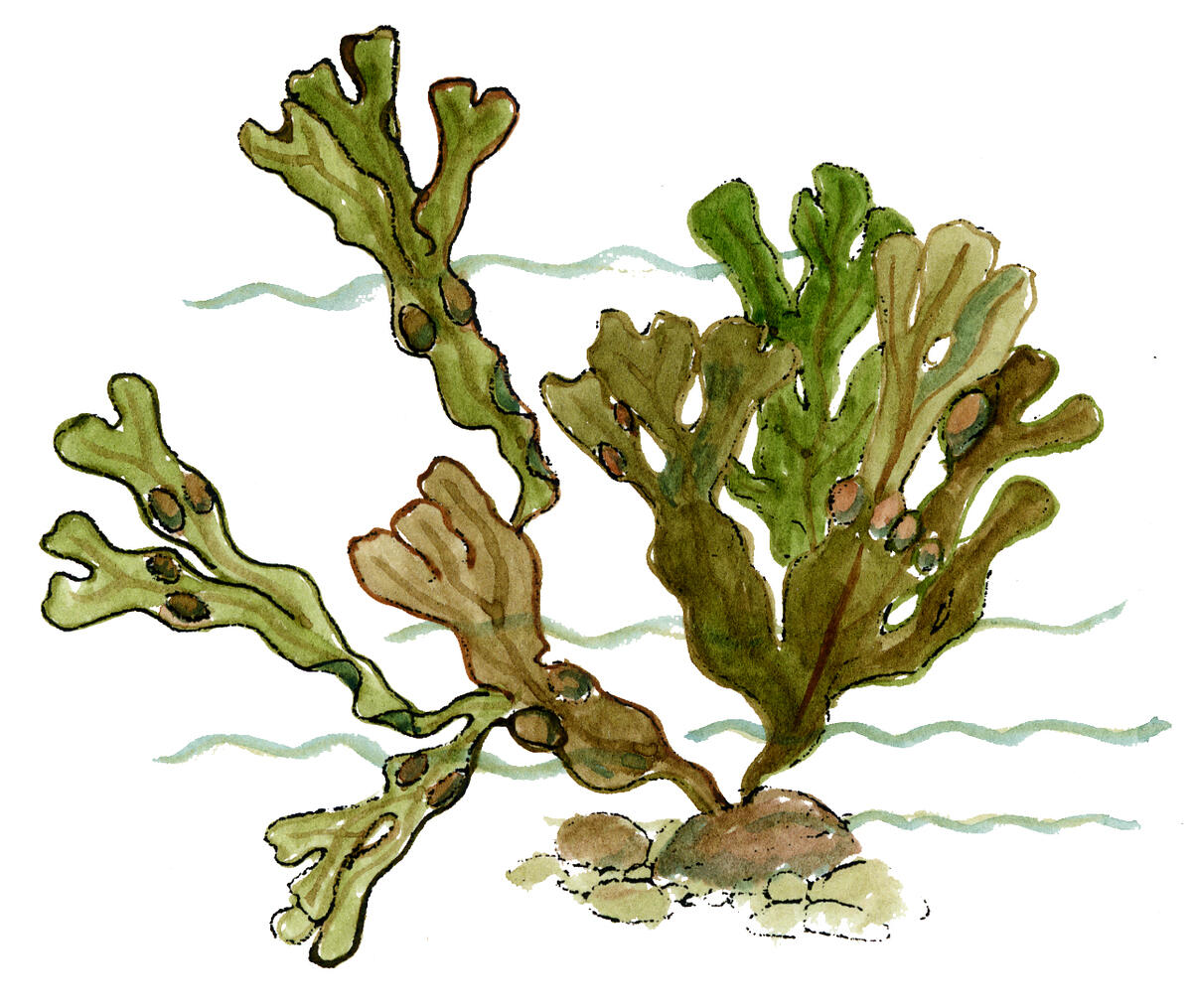
Near the shore, a pike waits under cover to ambush small fish. Striped little perch swim together, observing the predator. In the open sea, herring and sprat swim in large shoals. Freshwater perch and saltwater herring meet one another here on the coast of Uutela. This meeting is possible because the Baltic Sea’s brackish water, a mix of fresh and salt water, is suitable for both species of fish.
Whitefish, salmon and herring swim in the open sea. Both whitefish and salmon are natural predators in the Gulf of Finland, but today most fish are stocked into the sea. Fish stocking is necessary because spawning in natural rivers is no longer possible in many places.
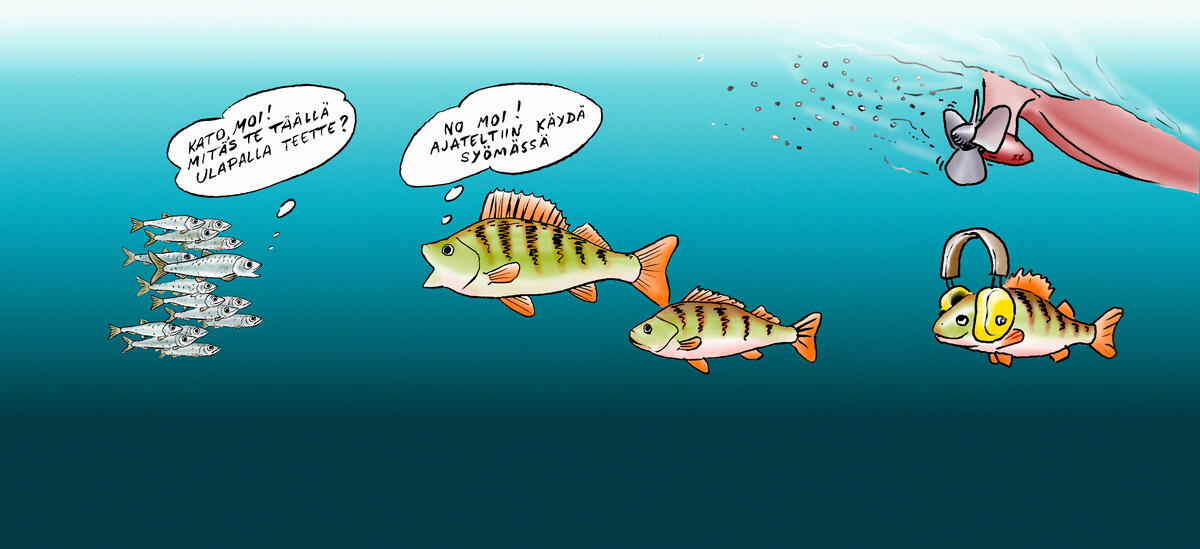
Spruce mires form when heath forests become saturated with water. The transformation to a mire begins when more water accumulates in a low-lying area than can drain out or evaporate. For a spruce mire to form, it requires rich soil and flowing, oxygen-rich water. Many fastidious plants thrive in mires.
Spruce, a plant that tolerates lots of shade and water grows happily in mires, crowding out the trees that need light. That’s why mires are often dark and enchanting places. Can’t you just imagine a gnome or elf peeking out from behind a spruce tree?
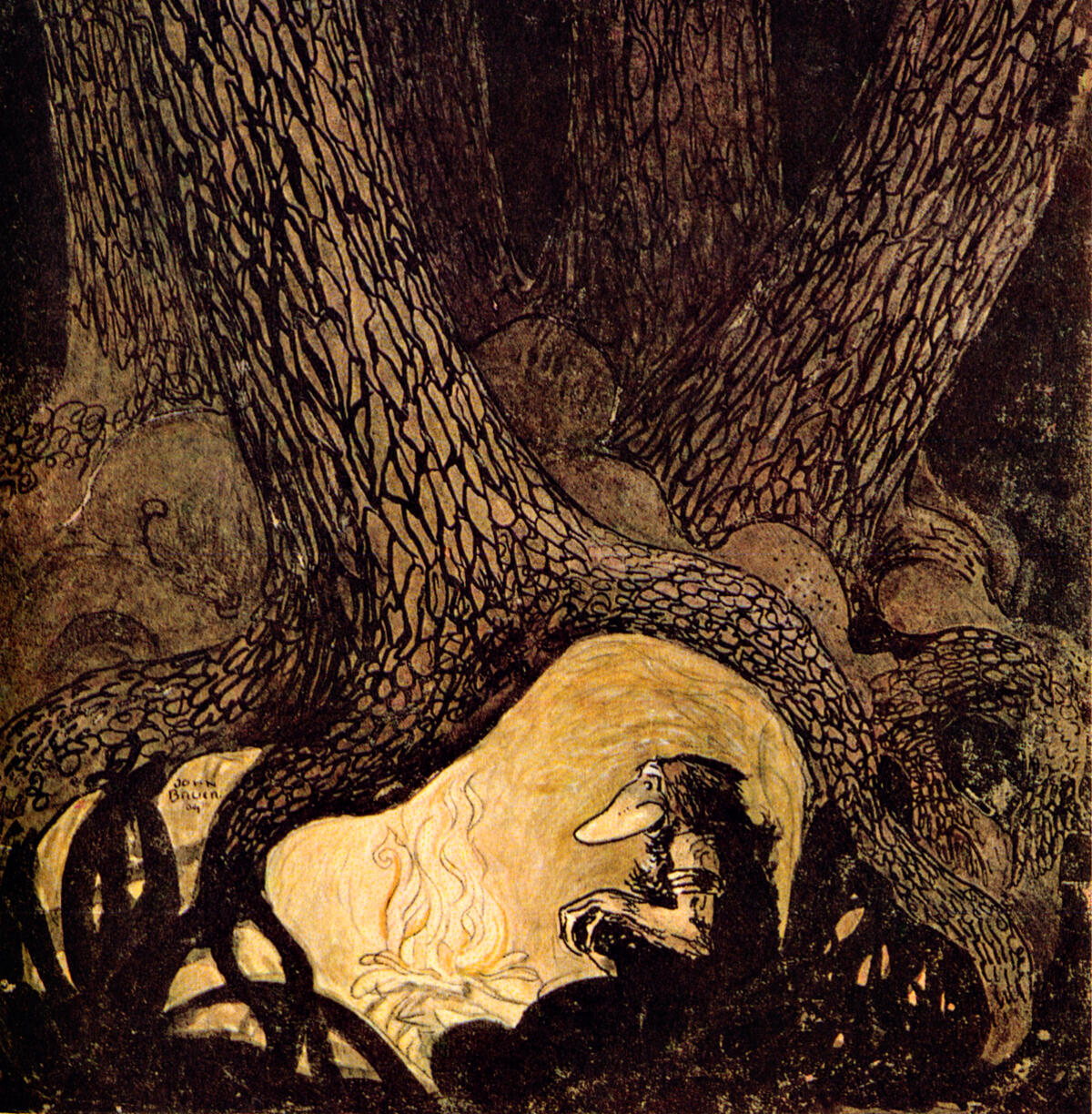
The nature trail ends here. We hope your visit was rewarding! You can return to the starting point at the Särkkäniemi car park, or towards Aurinkolahti and the beginning of the other tour of the nature trail. If you’re not tired yet, you can also head to the tip of Skatanniemi to admire the stunning glaciated rock formations and seascape. You can explore fortifications from the First World War along the route to Skatanniemi.